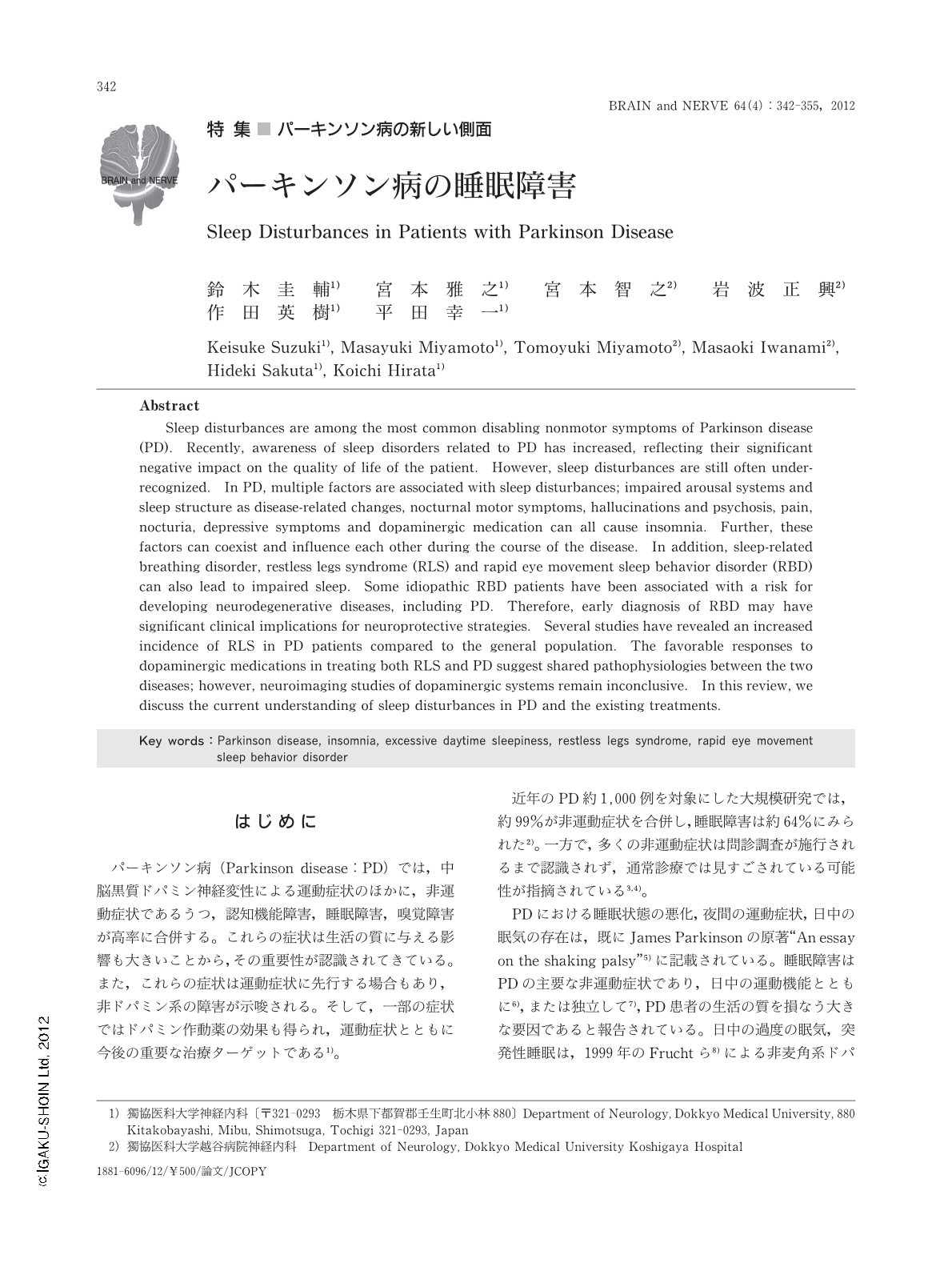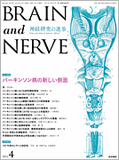Japanese
English
- 有料閲覧
- Abstract 文献概要
- 1ページ目 Look Inside
- 参考文献 Reference
はじめに
パーキンソン病(Parkinson disease:PD)では,中脳黒質ドパミン神経変性による運動症状のほかに,非運動症状であるうつ,認知機能障害,睡眠障害,嗅覚障害が高率に合併する。これらの症状は生活の質に与える影響も大きいことから,その重要性が認識されてきている。また,これらの症状は運動症状に先行する場合もあり,非ドパミン系の障害が示唆される。そして,一部の症状ではドパミン作動薬の効果も得られ,運動症状とともに今後の重要な治療ターゲットである1)。
近年のPD約1,000例を対象にした大規模研究では,約99%が非運動症状を合併し,睡眠障害は約64%にみられた2)。一方で,多くの非運動症状は問診調査が施行されるまで認識されず,通常診療では見すごされている可能性が指摘されている3,4)。
PDにおける睡眠状態の悪化,夜間の運動症状,日中の眠気の存在は,既にJames Parkinsonの原著“An essay on the shaking palsy”5)に記載されている。睡眠障害はPDの主要な非運動症状であり,日中の運動機能とともに6),または独立して7),PD患者の生活の質を損なう大きな要因であると報告されている。日中の過度の眠気,突発性睡眠は,1999年のFruchtら8)による非麦角系ドパミンアゴニスト服用中のPD患者の自動車事故の報告から,ドパミン作動薬との関連が見出され,社会的に注目を集めた。その後の研究によりすべてのドパミン作動薬が眠気を起こす可能性があり,疾患自体の影響として眠気を生じることが明らかになっている。
1996年にはSchenckら9)により,夜間の夢の行動化を起こす,REM睡眠行動異常症(rapid eye movement sleep behavior disorder:RBD)がPDを含む神経変性疾患の前駆病態である可能性が示唆された。レストレスレッグス症候群(restless legs syndrome:RLS)は,地域差はあるが,一般人口に比してPDに多く合併すると報告され,ドパミン系障害が共通する病態であるのかどうかは興味深い点である。また,ベッドサイドで施行可能である睡眠障害の評価方法として,Chaudhuriら10)が開発したParkinson's disease sleep scale(PDSS)は,PDに関連した夜間症状の評価に適切なツールとして広く用いられており,最近改訂版であるPDSS-2が公表された11)。本稿では,PDの睡眠障害における病態・治療について述べる。
Abstract
Sleep disturbances are among the most common disabling nonmotor symptoms of Parkinson disease (PD). Recently,awareness of sleep disorders related to PD has increased,reflecting their significant negative impact on the quality of life of the patient. However,sleep disturbances are still often under-recognized. In PD,multiple factors are associated with sleep disturbances; impaired arousal systems and sleep structure as disease-related changes,nocturnal motor symptoms,hallucinations and psychosis,pain,nocturia,depressive symptoms and dopaminergic medication can all cause insomnia. Further,these factors can coexist and influence each other during the course of the disease. In addition,sleep-related breathing disorder,restless legs syndrome (RLS) and rapid eye movement sleep behavior disorder (RBD) can also lead to impaired sleep. Some idiopathic RBD patients have been associated with a risk for developing neurodegenerative diseases,including PD. Therefore,early diagnosis of RBD may have significant clinical implications for neuroprotective strategies. Several studies have revealed an increased incidence of RLS in PD patients compared to the general population. The favorable responses to dopaminergic medications in treating both RLS and PD suggest shared pathophysiologies between the two diseases; however,neuroimaging studies of dopaminergic systems remain inconclusive. In this review,we discuss the current understanding of sleep disturbances in PD and the existing treatments.

Copyright © 2012, Igaku-Shoin Ltd. All rights reserved.


